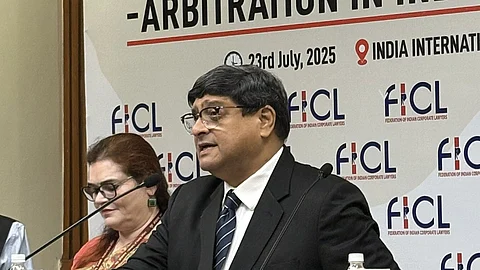
- Latest Legal News
- News
- Dealstreet
- Viewpoint
- Columns
- Interviews
- Law School
- Legal Jobs
- हिंदी
- ಕನ್ನಡ

Supreme Court judge Justice Sudhanshu Dhulia recently described arbitration in India as “rich man’s litigation” and raised doubts about whether the system is delivering on its promise of speedy dispute resolution, particularly given the extent of court interference and pendency.
Justice Dhulia questioned the accessibility and equity of arbitration in its current form.
“Arbitration is a rich man’s litigation. Poor people don’t go for it," he said.
He was speaking at a symposium titled “Arbitration in India – The Road Ahead” organised by the Federation of Indian Corporate Lawyers (FICL) on July 22.
He was joined by Dr. Anju Rathi Rana, Law Secretary at Department of Legal Affairs as the guest of honour.
While tracing India’s long tradition with arbitration, even in family settings Justice Dhulia said that equity was historically the main reason it was preferred over normal litigation. However, that promise is now diluted, he opined.
“The main purpose of arbitration is that the dispute should be resolved speedily. Is it happening?” he asked.
He recounted his experience as a judge of the Uttarakhand High Court, where he saw parties litigating Section 11 (appointment of arbitrators) disputes for over a decade.
“People were fighting for 10-15 years, some were references from the 1940 Act. Sometimes arbitration is referred to as Alternate Dispute Resolution (ADR). How is it alternate if there is so much court interference? Something has to be done,” he said.
On the recent office memorandum issued by the Central government restricting arbitration in government contracts below ₹10 crore, Justice Dhulia noted that it reflected government's 'pain' over arbitrations not going in its favour.
Justice Dhulia expressed skepticism about India’s ambition to become an international arbitration hub, stating that institutional arbitration is still not the norm domestically.
“In international arbitrations, it is mostly institutional arbitration. But in India, it’s mostly ad hoc. Unless institutional arbitration becomes a culture, India's ambition of becoming a hub for arbitration may face roadblocks,” he stated.
He also flagged alarming pendency statistics.
As of February 2024, he said the Supreme Court had over 132 petitions related to appointment of arbitrators and more than 1,000 petitions relating to other aspects of arbitration.
“The basic requirement of arbitration is speedy justice — is it happening? Arbitration has lessened the burden of the civil court but increased the burden of High Courts and the Supreme Court,” he said.
On the question of reforms, he added that the opportunity lies with the legal and policy community to recommend changes.
“A lot of time is taken in Sections 34 and 37. Some changes need to be brought. Then it might be useful... Better drafting of the Act will be very useful.”
Law Secretary Dr. Anju Rathi Rana highlighted the government’s ongoing efforts to improve arbitration infrastructure and legislation.
“Arbitration at its heart is a measure of trust. Over the last decade, the Arbitration Act has undergone a series of amendments with clear objectives. 2015 marked a clear change from procedural uncertainty to procedural discipline.”
Rana said that the India International Arbitration Centre (IIAC) is designed to compete with global institutions “in both form and credibility.”
She stressed that a modern arbitration ecosystem must be faster and future-ready.
“The government’s focus has not just been on legislative modernisation but on transforming the mindset with which we approach dispute resolution,” Rana said.
Success of legislation depends on implementation and building a credible arbitration ecosystem is a shared responsibility, she stated.
“It is not the job of one institution or ministry, it lies equally with everyone. The road ahead is full of potential. Arbitration in India is moving to the mainstream,” Rana opined.